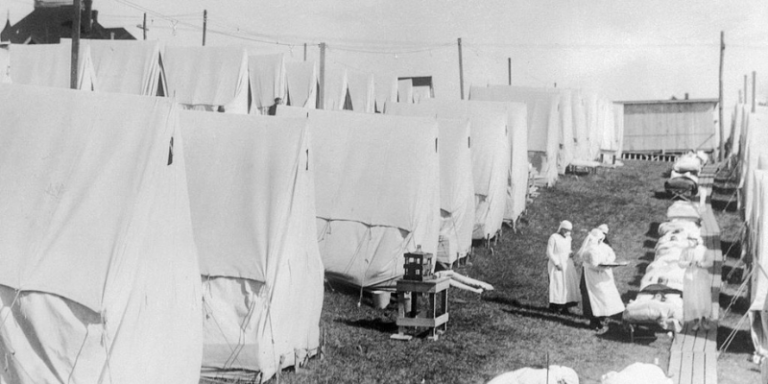Pandemics in the 21st Century
How science and the modern lifestyle have impacted the spread of a virus.
By: Kelli Ballard | March 24, 2020 | 512 Words

Fresh air cure for the Spanish influenza. 1917-18 photo. (Getty Images)
The Coronavirus pandemic has caused a lot of confusion as state after state orders residents to stay at home. Fear has caused panic buying so that stores are having difficulty keeping up with everyday materials such as toilet paper, while blame has been tossed at President Donald Trump over whether he is taking the right measures to protect the American people. This is not the first pandemic the United States has endured, but the ways in which we are fighting it are a bit different from those in the past.
The Spread of a Disease
A pandemic is different from an epidemic because the former spreads globally while the latter remains within a particular geographical area. Once upon a time, a disease could be easily contained to just part of the planet – for example, one of the most famous deadly diseases, the Bubonic Plague, was limited to only Europe and parts of Asia, and it took years to spread across the region in the 1300s. As the world became more modern, people traveled further distances, which meant carrying viruses and bacteria to other locales was easier. This was first seen with the 1889-1890 flu pandemic that started in Russia and took only five weeks to spread over the globe – before the invention of airplanes.
The 1918 Spanish Influenza (which didn’t really originate in that country) is perhaps the most well-known and deadly pandemic to reach the U.S. so far. That virus took more lives than World War One, which occurred during the same time frame. The close quarters of the soldiers contributed to the spread, and treatment was difficult since medical knowledge wasn’t as advanced as it is today.
Medical Progress
Since the 1918 pandemic, there have been a couple of significant outbreaks: the Asian Flu (1957-1958), H1N1 Swine Flu (2009-2010), and now Coronavirus or COVID-19 – the “19” representing the starting year of the outbreak, 2019.
Throughout history, people were mystified by epidemics and had little knowledge about how to treat or prevent diseases. In the 21st century, medical progress has given us a far better chance to deal with these illnesses before they gain a substantial foothold. The H1N1 virus was serious, but a vaccine was soon developed. With each epidemic and pandemic, we learn something new and use it to improve our responses. Today’s modern technology and medical knowledge have brought us a long way, and the social distancing of 2020 is just one method being used to save as many lives as possible. We’ve been able to develop vaccines for various types of flu and antibiotics to treat bacterial infections.
Health professionals now know that washing hands for at least 20 seconds is needed to protect against catching or spreading bacterial and viral diseases. Restricting travel and non-essential activity is also imperative to preventing the spread. While some measures were taken during the 1918 Spanish Flu, not enough was known about the science to meet the population’s needs effectively. The United States has shut down its borders, recognizing the importance of stopping people from traveling and spreading the Coronavirus.
















